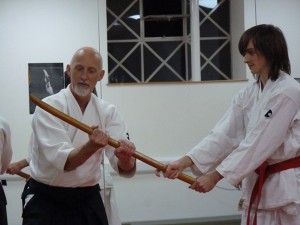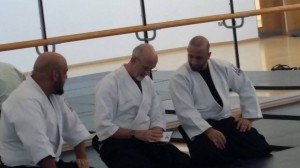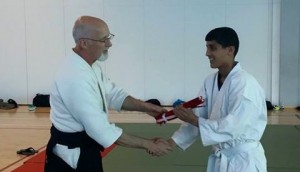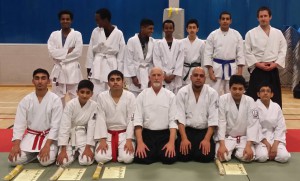The Possibilities are Endless by Mark Peckett
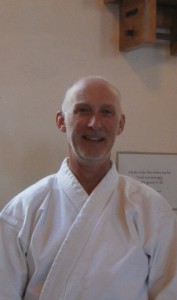 The other night in class I was explaining how many aikido techniques there are. One or two students were quite disappointed when I came up with only about sixteen main ones – five immobilisations and eleven projections. “Is that all?”
The other night in class I was explaining how many aikido techniques there are. One or two students were quite disappointed when I came up with only about sixteen main ones – five immobilisations and eleven projections. “Is that all?”
And to be fair to myself, the number of aikido techniques has been distilled down to even less than that by some practitioners. Here are what they consider the five essential forms:
1. Ikkyo
2. Shiho-nage
3. Irimi-nage
4. Kokyu-nage
5. Koshi-nage.
After that, the class turned into a lesson in mental mathematics. First of all, all of those techniques can be done either as an irimi or a tenkan move. That takes us up to sixteen times two: thirty-three. Then we multiply that number by the number of attacks which is generally listed at about twenty three (this was where I would normally have reached for the calculator, and I have done now to check my reckoning for this blog): it comes out at three hundred and sixty-eight.
Then there are suwari waza (sitting techniques) and hanmi handachi waza (one sitting, one standing) versions of all three hundred and sixty-eight techniques. That takes me up to one thousand, one hundred and four! Then we have henka waza or changed techniques. Not all techniques are suitable to be changed to any other technique, but if you assume about fifty percent of them do then you are now up to one thousand, six hundred and fifty six techniques.
Then there are multiple attacks and there are kaeshi waza or counter techniques. And we haven’t even got to weapons techniques yet! After jo projections and immobilisations there’s knife-taking, sword-taking and jo-taking.
And kokyu techniques.
And then all the different circumstances in which the attack can take place – whether you are standing or seated, have a lot of room to move, or very little, uneven ground, in the dark. It never ends.
The point I was trying to make was that there is more than enough in aikido to last us a lifetime if all we’re interested in is collecting techniques. After that there’s another lifetime required to polish them, and several lifetimes after that to learn the different ways that different people have of doing them.
So really, within certain basic principles, the techniques and variations are infinite.
I suppose some people could regard it as depressing that there is so much to learn and so little time, but I find it exciting.
In a lecture given by the Founder himself, called “The Harmony of Love” O-Sensei said:
Aikido is none other the manifestation of the workings of love. Love gives form to the universe and purifies all things. The universe scatters the seeds from which all things grow; it contains the infinite [my emphasis] power which nourishes and allows them to prosper.
He goes on to say:
The actual forms of the universe are revealed within the human body. We must begin to see the universe within us and awaken to the principles of balance and love … the universe unfolds in a never-ending mosaic of many forms; each one a different aspect of its fullness, each one in balance with all others.
What he seems to be saying is that aikido is an opportunity to look beyond our small lives and connect with the infinite. And the best thing about this is that it is not a mystical process, it is very practical, and each improvement in our practice is reflected in our daily lives.
For example, one of my teachers used to say to me, when my techniques were too small and fussy, when I was staring at what I was doing with my hands, “you must try to touch the walls and the ceiling with your hands.” And when I thought my movements were becoming bigger, “touch the trees outside, touch the sky, touch the moon.”
There aren’t many things we do in our everyday lives that encourage to become so big we can touch the sun. In the Buddhist Metta Bhavana meditation practice, a similar thing happens. In the first stage, you think with unconditional loving-kindness of yourself; then a good friend; then a person towards whom your feelings are neutral; then someone you actually dislike; and finally, all four people together, and then allowing that feeling of unconditional loving-kindness to spread on throughout the world to all living beings everywhere. This meditation encourages us to touch the infinite with love.
Buddhists do it by sitting, aikidoka do it through their practice of techniques. I find myself now telling students of my own to reach out beyond the walls of the dojo, to try and touch the sky.
I also see improvements in my students’ performance when I tell them to do something as simple as turning their head during a technique. From a purely mechanical point of view, the head leads the body and generates greater momentum, just like a ballet dancer. But sensei like Morihiro Saito and Shigemi Inagaki emphasise that in aikido every attack should be consider a multiple attack, and therefore you should always be turning to face the potential enemy behind you.
This awareness is commonly called zanshin and translates roughly as “remaining mind”. It is a state of relaxed alertness. But the just-thrown uke is only a small part of one’s surroundings. There’s the dojo, its walls and ceiling, and outside there are the trees, the sky, the moon and the sun.
This means that when we are practising aikido it is constantly putting the infinite in all of us, if we’re prepared to explore it. It doesn’t mean we have to be trying to touch the sky all the time, just acknowledging the potential.
So we might be working on ikkyo, possibly that aspect of it which some practitioners call “connectedness”. There is the connection between you and your partner and then there is the connection you have with yourself. You have to be able to harmonise with yourself in order that you can move in harmony with someone else.
And this is enough to be working on – the infinite can wait. But because the infinite is implicit in aikido, we don’t have to seek it. We can keep on working on the details and aikido will lead us to the infinite anyway.


